HMS Activity is one of the many one-off converted British escort carrier converted from the Royal Navy during the Second World War. She was a merchant vessel requisitioned on slip and converted (pennant D94), recommissioned in late 1942 and only carrying ten aircraft, mostly Swordfish and Martlets of the 819 and 812 Squadrons. During the war, she took part in several escort missions in the North Atlantic and to Murmansk. In 1944-45 she became an aircraft ferry to the Indian Ocean and Pacific. She returned after the war into merchant service, as MV Breconshire, until retired in 1967.
Origin and conversion
When construction started in 1940 she was the refrigerated cargo ship “Telemachus” paid for by the Alfred Holt Line, built by Caledon Shipbuilding & Engineering Company, Dundee, Scotland. By February 1941 however still not ready for launch, she was taken over by the Ministry of War Transport, renamed Empire Activity to serve in her intended role but under state supervision. The RN, desperate of having new escort carriers requisitioned her by January 1942, by order of the Admiralty for conversion to an escort carrier. From Empire Activity she was renamed HMS Activity, awarded the pennant number D94.
She was launched in May 1942 and the conversion commenced, completed in just four months, by August. She was completed but trialled and worked up at Lamlash then sent to Rosyth for fixes. Indeed she was officially commissioned by 29 September 1942 but not operational before 1st January 1943, and only as a deck landing training carrier, until October 1943, then she was sent to Liverpool for yer another refit, and only really entered active service in early 1944.
Design of the class
Hull and general design
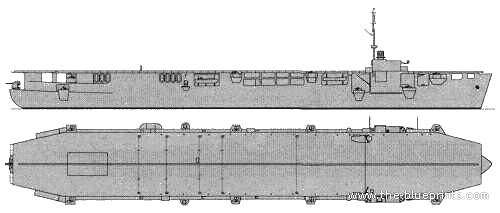
In four months, conversion work was minimal. She displaced 11,800 tons standard as completed, 14,250 tons fully loaded. She measured 512 ft 9 in in lenght (156.29 m) for a beam of 66 ft 6 in (20.27 m) and a Draught of 25 ft (7.65 m).
She kept her original hull and weather deck and the hangar was built above, yet unlike MAC ships she received a true hangar: The flight deck measured 151.8 m long () for 20.1m wide () and total superficy of 3,051m² (), whereas the 6.4m () height hangar represented approximatively 1,275m² () in surface -so half the deck surface- or 8,160m³ () in volume. There was a single lift aft measuring 12.8 m by 6.1m () weighting 4.5t and large enough for folded aircraft to a weight corresponding to the Swordfish and Albacore. Aircraft fuel stowage in total represented 90,900 liters.
Her straboard island was minimalist with a deported structure and open bridge, supporting a fire control tower and pole, composite mast aft. Stability was seemingly okay, but only after significant work: 1600t of solid ballast as added in her outer hull, which in addition was more thoroughly sub-divided into extra compartments. Control stations were protected by splinter protection only, but otherwise she carried not armiour at all.
Powerplant
She kept of course her original merchant powerplant on two shafts, with robust and frugal but massive Burmeister & Wain diesels, for a total of 12,000 hp (8,900 kW) in output. This was enough to propel her to 18 knots (21 mph; 33 km/h) when chased by an U-Boat. She carried 2,015 tons total of diesel oil and her endurance was 15,000 nm at 16 knots.
Armament
This was limited by the structure, but despite her hangar was short her flight deck was practically full lenght without enough space free at the bow, but the poop deck was sufficiently low to house a unique twin 102mm/45 (4 inches) standard dual purpose QF Mk XVI, and apparently later Mark XIX. It was completed by ten twin 20mm/70 Oerlikon Mk II/IV anti-aircraft guns as well as four single 20mm/70 Oerlikon Mk II/IV (later replaced by twins). They were not as efficient as Bofors, especially in 1944, but sponsons space available was not sufficient and this reduced top weight. These sponsons were located at two level along the hull and not crossing the flight deck (side sector defence only). The main 4-in/45 was also limited in traverse, as in elevation with the flight deck above.
Sensors
HMS Activity was fitted by a Type 281, and a Type 272 radar and well as a Type 127 sonar:
Type 281 Radar: Early-warning 350 kW–1 MW radar. Frq 86–94 MHz PRF 50/sec, bwt 35° (horiz) pwdt 2–3 μs or 15 μs, range 115 nmi (213 km; 132 mi) alt. 30,000 feet (9,100 m)
Type 272 Radar: Improved 28 in (0.71 m) 271 radar, 5 kW-70 kW, Frq 2950 ±50 MHz (S-band) PRF 500 pps, bwdt 8.6º hor, 85º vert, Pwdt 1.5 µs 2 rpm range 1-11 nm (1.9–20.4 km) Prec ~2º, 250 yards range.
Type 127 sonar: Sonar type usually installed on British sloops, first with a bearing plotter.
Modernization only included the replacement of four single 20mm/70 Oerlion by twins Mk II/IV.
When decommissioned, Activity had thus fourteen twin 20mm/70 Mk V and kept her electronics suite.
Air Group
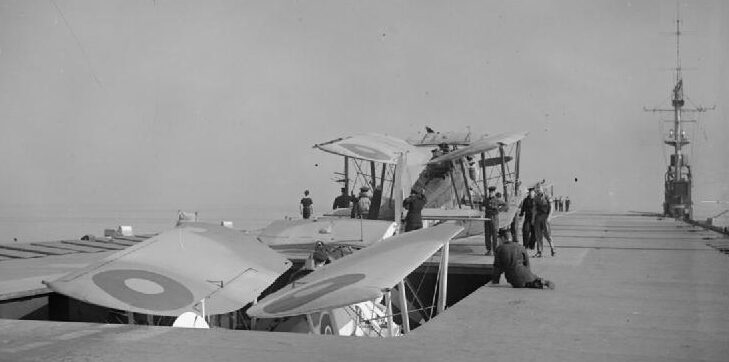
Swordfish of 824 Sqn. one lifted up, one taking of.
She could take aboartd up to 10 aircraft in hangar, but up to 15 or even more total depending of the type (She operated in her career the Sea Hurricane, Seafire, the Brewster Buffalo, Martlet fighters and Swordfish torpedo bombers)
By October 1942 whe entering service she ony had six Swordfish, but by Januart 1943 she carried twelve Swordfish, two full squadrons. The old “stringbag” was still a very efficient torpedo/ASW platform.
By August 1943 after another refit she was now able to carry 7 Martlet fighters (Wildcat) in complement to 7 Swordfish, so a complete air group for any mission.
In 1944 this varied a lot. By January she reportedly had 3 Martlet, 9 Swordfish, then 7 Martlet, 3 Swordfish, so mission dependent.
By September 1944 she started to take a ferry role and carrier 21 Avenger, probably all on deck. Two months afterwards, she carried 15 Barracuda, which was low enough to fit inside the hangar, so seemingly this was her permanent park, split between the hangar and deck. On September 1945 she reportedly carried 12 Barracuda.
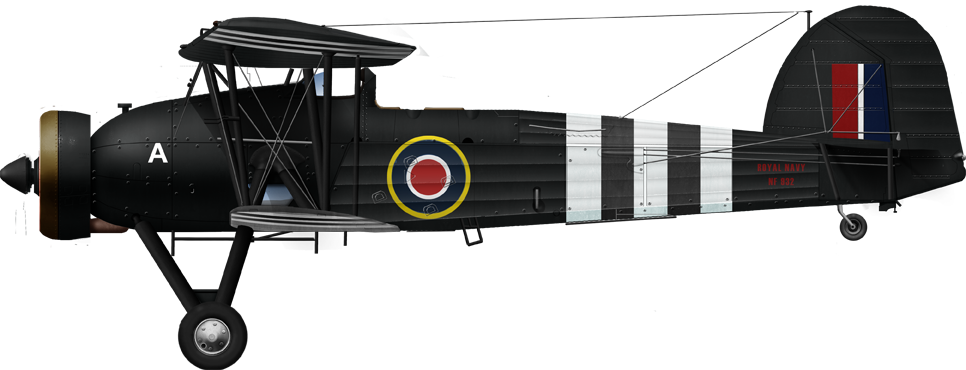
Fairey Swordfish of 819 NAS, western approaches mid-1944
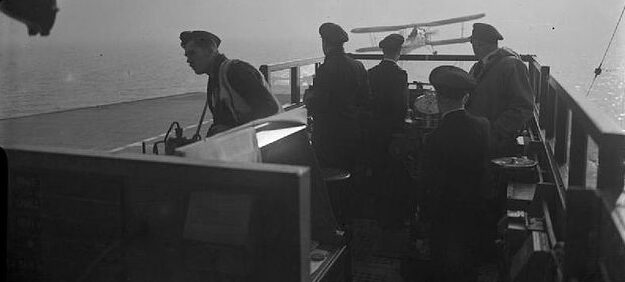
conways profile
⚙ HMS Activity specifications |
|
| Displacement | 11,800 tons, 14,250 long tons fully loaded |
| Dimensions | 512 ft 9 in x 66 ft 6 in x 25 ft (156.29 x 20.27 x 7.6 m) |
| Propulsion | 2× shafts, Burmeister & Wain diesels 12,000 hp (8,900 kW) |
| Speed | 18 knots (21 mph; 33 km/h) |
| Range | Diesel oil 2,015 tons, endurance 15,000 nm/16 knots |
| Armament | 2× 4 in (100 mm) guns, 20× 20 mm (0.79 in) AA autocannons |
| Protection | None |
| Sensors | Type 281, Type 272 radars, Type 127 sonar |
| Air Group | 10 aircraft (hangar), lift 42 ft × 20 ft (12.8 m × 6.1 m) |
| Crew | 700 |
Career of HMS Activity

HMS Activity was laid down in February 1940 and one year after exactly while still in construction (at low rate) she was taken over by the Ministry of War Transport. She never was completed as Empire Activity but instead, again almost one year later and still not launched by January 1942 she was requisitioned by the Admiralty for conversion, launched in May 1942, completed in August, Entering service officially on 1 January 1943 but really starting active service after her last refit by late 1943. She acted as fliht deck trainer with 835 Naval Air Squadron swordfish aboard. These Deck Landing Training flying operations were operated from RNAS Machrihanish.
Her NAS was landed when trainiong with Swordfish, Fulmar, Martlet, Sea Hurricanes and Seafires. In October she trained with 768 DLT squadron. She also had about 5-6 landing accidents, mostly sea Hurricanes and Fulmars. She also trained 838 squadron. She earned 819 Sqn from HMS Archer also when she was in repairs.
Atlantic and Arctic 1944
HMS Activity started training as convoy escort ship, North Atlantic. This was called “Trade Protection Duties, Western Approaches”, from January to March 1944. She had the 819 Naval Air Squadron aboard from 12 January 1944. These were 7 Swordfish and 3 Martlet from RNAS Belfast. Her first trip and combat mission started on 29 January, as part of the Second Escort Group. She would escort the convoys OS 66, KMS 40, ON 222, NS 28, SL 147, MKS 38, HX 277, KMS 43 and MKF 29 from there to March 1944. It seems she did not had serious encounter during this period while her pilots multiplied covering flights (with her squadron of martlets to deal with rogue Luftwaffe floatplanes and the FW-200 Condor) and ASW patrols.
Next, she was assigned to the difficult Arctic route, escorting convoy JW 58 to Murmansk. This time, German activity was fierce in the area, and with HMS Tracker’s air group, she managed to track and sink of U-288, and U-355, damaging as well U-362, U-673 and U-990 in the single mission. The carriers basically rampaged through the entire wolfpack. With the assurance of a job well done she covered the return convoy—RA 58 withiout a hitch, they all safely reached their destination without a single loss.
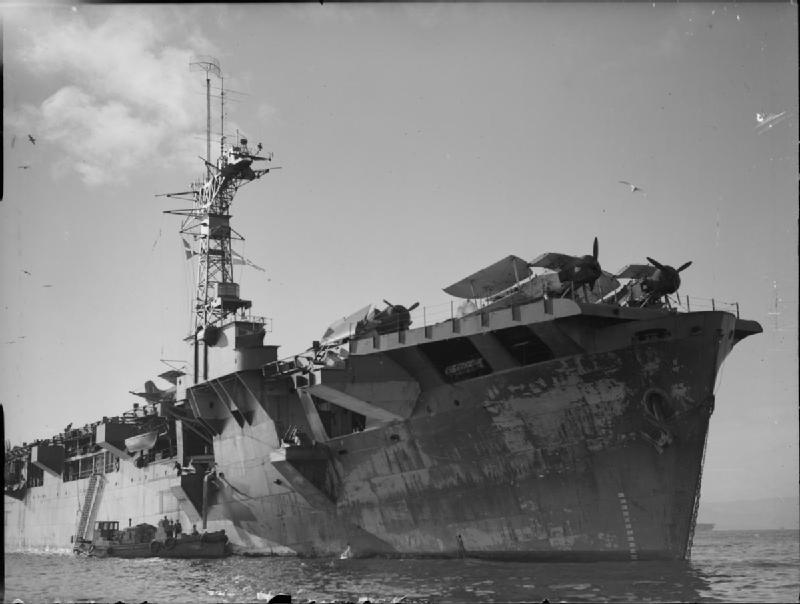
In May 1944, HMS Activity spent was drydocked for essentiual maintenance and some fixes, in a shipyard on the Clyde, also working out remaining defect. When done after a short refresher training she joined the Second Escort Group, for escort missions again. She was thus responsible of the escort of convoys OS 78, KMS 52, SL 158, MKS 49, OS 78, KMS 52, AL 159, MKS 50, SL 162, MK 53, KMF 33, MKF 33, OS 86, KMS 60, SL 167 and MKS 58. This unrelentless service earned her two awards: Atlantic 1944, Arctic 1944-45. This was basically the most perilous part of her wartime career. After that she would mostly do ferry work far from U-Boat routes.
Indian-Pacific service 1944-45
In August 1944, the Admiralty’s needs changes as the RN was not needed as much in the European theater. The Atlantic was not more secured, as was the Mediterranean, and Norway was almost under control, with Tirpitz days numbered, and most remaining Kriegsmarine ships either sunk or in repair. Attention turned to the Pacific and far east. HMS Activity was reclassed as a ferry carrier. meaning she would only transported aircraft, personnel and supplies to Trincomalee in Ceylon. She arrived there on 23 October 1944 via Gibraltar and Suez, and did the same in the reverse escorting convoy MKF 36 back to home along the way via the Bay of Biscaye now free of axis activity.
HMS Activity was drydock for maintenance in the Clyde by December 1944, the crew taking a Xmas wekk deserved R&R, while some rectifications were made. She was reallocated in February 1945 to the East Indies Fleet, under the new pennant R301. She sailed with convoy KM 39 on 29 January 1945 by the same Mediterranean route and made it to Colombo on 20 February. Then she proceeded to the Pacific, reaching Sydney. En route she rescued 92 survivors from SS Peter Silvester (US liberty ship sunk by U-862 on 6 February 1945). This cargo was also the last Allied ship sunk in the Indian Ocean due to sub activities. Grateful survivors were landed at Fremantle. HMS Activity spent some time Sydney and it was questioned of supporting the British Pacific Fleet (BPF) service as second line ferry.
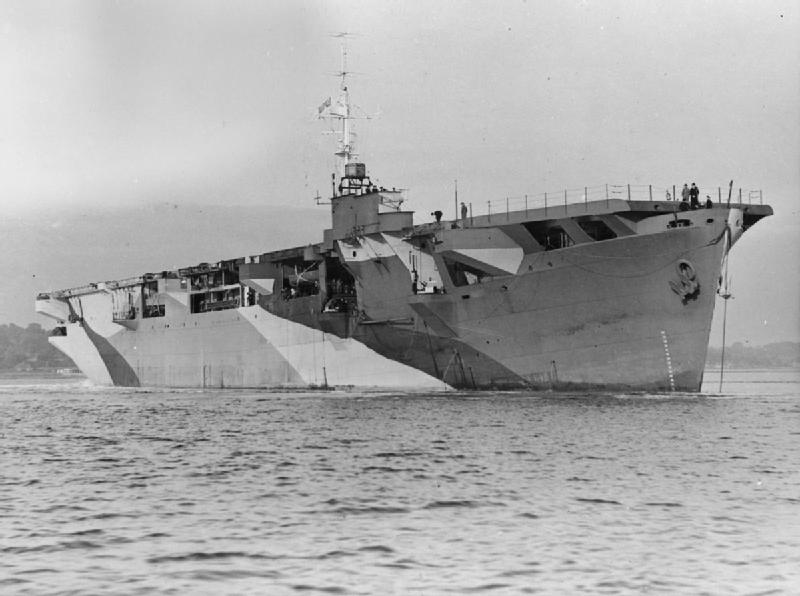
HMS Activity departed Sydney on 24 March for Colombo and be used again as aircraft ferry, from Cochin to Colombo. In September-October 1945, HMS Activity was sent to Singapore, helping the landings and re-occupation of Singapore. She carried back POWs and passengers to Trincomalee on 15 September. She completed her trip for home via Suez and Gibraltar and arrived at the Clyde on 20 October 1945 to be drydocked, decommissioned the same day. Then she was placed in the Reserve Fleet, later Category B Reserve (30 January 1946), so to be sold to the civilian marker. Glen Lines acquired her on 25 March 1946, and paid for a conversion back into a merchant ship whith her holds intact, and possibly her former structure, removed in 1942 during conversion.
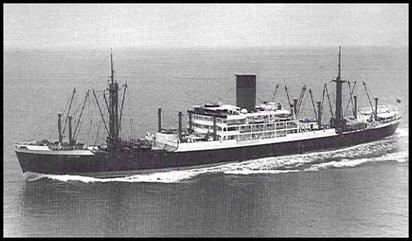
Merchant Navy: MV Breconshire
She became a new Glenearn class merchant ship, being converted back at Palmers Yard, Hebburn-on-Tyne. She was renamed MV Breconshire, and entered service with Glen Line, by September 1947. After conversion, she was classed as a 9,061 gross register tons vessel, lenght 512 ft 8 in for 66 ft 4 in (156.26 x 20.22 m), her machinery still delivering 12,000 hp (8,900 kW) for her now worn out B&W diesel engines, and top speed was still 18 knots (21 mph; 33 km/h). Her machinery was likely overhauled after her WW2 service.
She served from September 1946 to April 1967, until sold on the 24th to a Kobe shipbreaker, sent to Mihara for scrapping in May 1967.
Note: This is a resume, for the full detailed record check this source: royalnavyresearcharchive.org.uk/ activity
Read More/Src
Books
Conway’s all the world’s fighting ships 1947-95
Links
royalnavyresearcharchive.org.uk
arctic.org.nz/
uboat.net/
web.archive.org/ fleetairarmarchive.net/ Activity
web.archive.org red-duster.co.uk/
en.wikipedia.org/ HMS_Activity_(D94)
navypedia.org activity.htm
naval-history.net/ Activity.htm
iwm.org.uk/
Model Kits
None, but 1/2400 wargaming found on shapeways

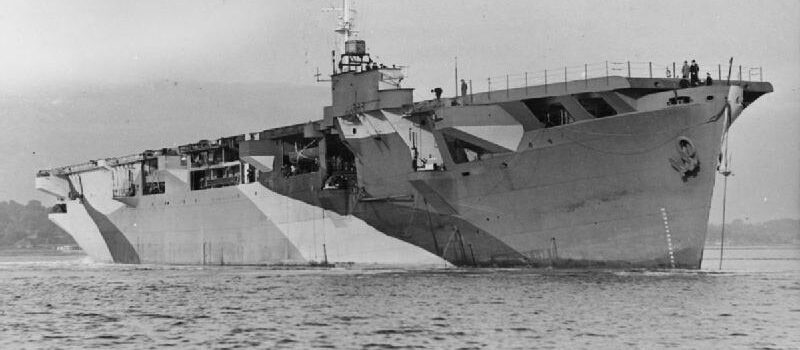

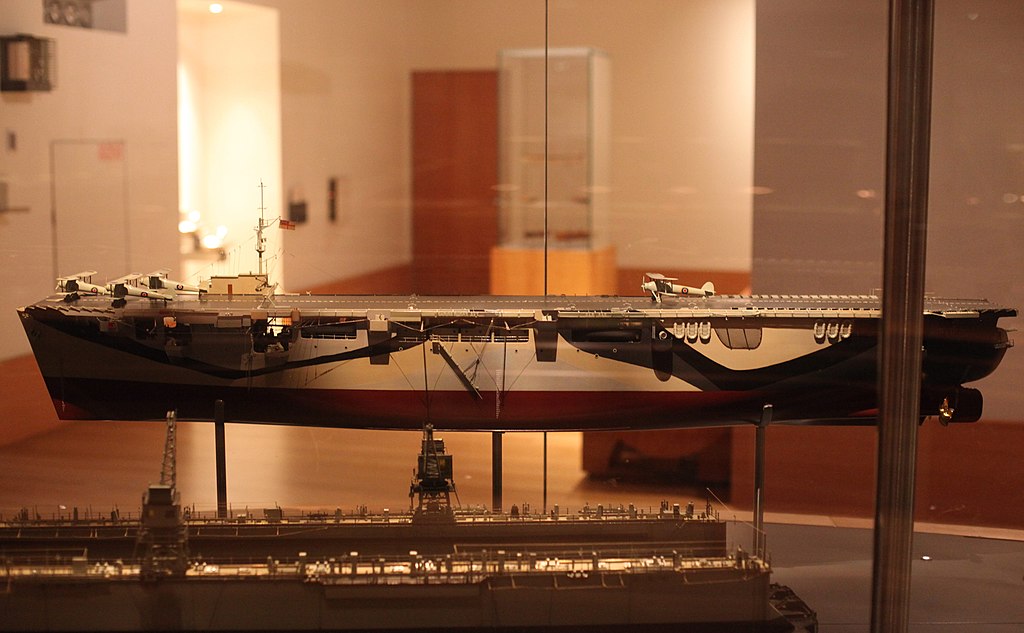
 Latest Facebook Entry -
Latest Facebook Entry -  X(Tweeter) Naval Encyclopedia's deck archive
X(Tweeter) Naval Encyclopedia's deck archive Instagram (@navalencyc)
Instagram (@navalencyc)





 French Navy
French Navy Royal Navy
Royal Navy Russian Navy
Russian Navy Armada Espanola
Armada Espanola Austrian Navy
Austrian Navy K.u.K. Kriegsmarine
K.u.K. Kriegsmarine Dansk Marine
Dansk Marine Nautiko Hellenon
Nautiko Hellenon Koninklije Marine 1870
Koninklije Marine 1870 Marinha do Brasil
Marinha do Brasil Osmanlı Donanması
Osmanlı Donanması Marina Do Peru
Marina Do Peru Marinha do Portugal
Marinha do Portugal Regia Marina 1870
Regia Marina 1870 Nihhon Kaigun 1870
Nihhon Kaigun 1870 Preußische Marine 1870
Preußische Marine 1870 Russkiy Flot 1870
Russkiy Flot 1870 Svenska marinen
Svenska marinen Søværnet
Søværnet Union Navy
Union Navy Confederate Navy
Confederate Navy Armada de Argentina
Armada de Argentina Imperial Chinese Navy
Imperial Chinese Navy Marinha do Portugal
Marinha do Portugal Mexico
Mexico Kaiserliche Marine
Kaiserliche Marine 1898 US Navy
1898 US Navy Sovietskiy Flot
Sovietskiy Flot Royal Canadian Navy
Royal Canadian Navy Royal Australian Navy
Royal Australian Navy RNZN Fleet
RNZN Fleet Chinese Navy 1937
Chinese Navy 1937 Kriegsmarine
Kriegsmarine Chilean Navy
Chilean Navy Danish Navy
Danish Navy Finnish Navy
Finnish Navy Hellenic Navy
Hellenic Navy Polish Navy
Polish Navy Romanian Navy
Romanian Navy Turkish Navy
Turkish Navy Royal Yugoslav Navy
Royal Yugoslav Navy Royal Thai Navy
Royal Thai Navy Minor Navies
Minor Navies Albania
Albania Austria
Austria Belgium
Belgium Columbia
Columbia Costa Rica
Costa Rica Cuba
Cuba Czechoslovakia
Czechoslovakia Dominican Republic
Dominican Republic Haiti
Haiti Hungary
Hungary Honduras
Honduras Estonia
Estonia Iceland
Iceland Eire
Eire Equador
Equador Iran
Iran Iraq
Iraq Latvia
Latvia Liberia
Liberia Lithuania
Lithuania Mandchukuo
Mandchukuo Morocco
Morocco Nicaragua
Nicaragua Persia
Persia San Salvador
San Salvador Sarawak
Sarawak Uruguay
Uruguay Venezuela
Venezuela Zanzibar
Zanzibar Warsaw Pact Navies
Warsaw Pact Navies Bulgaria
Bulgaria Hungary
Hungary

 Bundesmarine
Bundesmarine Dutch Navy
Dutch Navy Hellenic Navy
Hellenic Navy Marina Militare
Marina Militare Yugoslav Navy
Yugoslav Navy Chinese Navy
Chinese Navy Indian Navy
Indian Navy Indonesian Navy
Indonesian Navy JMSDF
JMSDF North Korean Navy
North Korean Navy Pakistani Navy
Pakistani Navy Philippines Navy
Philippines Navy ROKN
ROKN Rep. of Singapore Navy
Rep. of Singapore Navy Taiwanese Navy
Taiwanese Navy IDF Navy
IDF Navy Saudi Navy
Saudi Navy Royal New Zealand Navy
Royal New Zealand Navy Egyptian Navy
Egyptian Navy South African Navy
South African Navy






























 Ukrainian Navy
Ukrainian Navy dbodesign
dbodesign